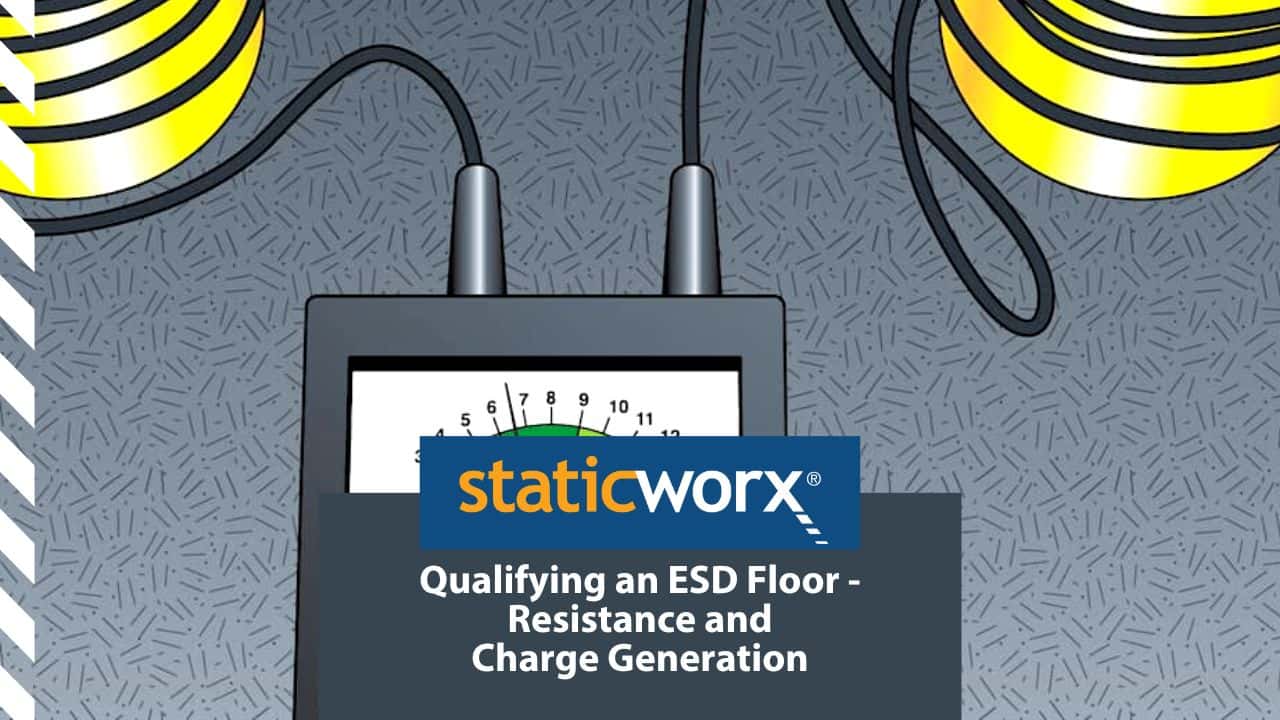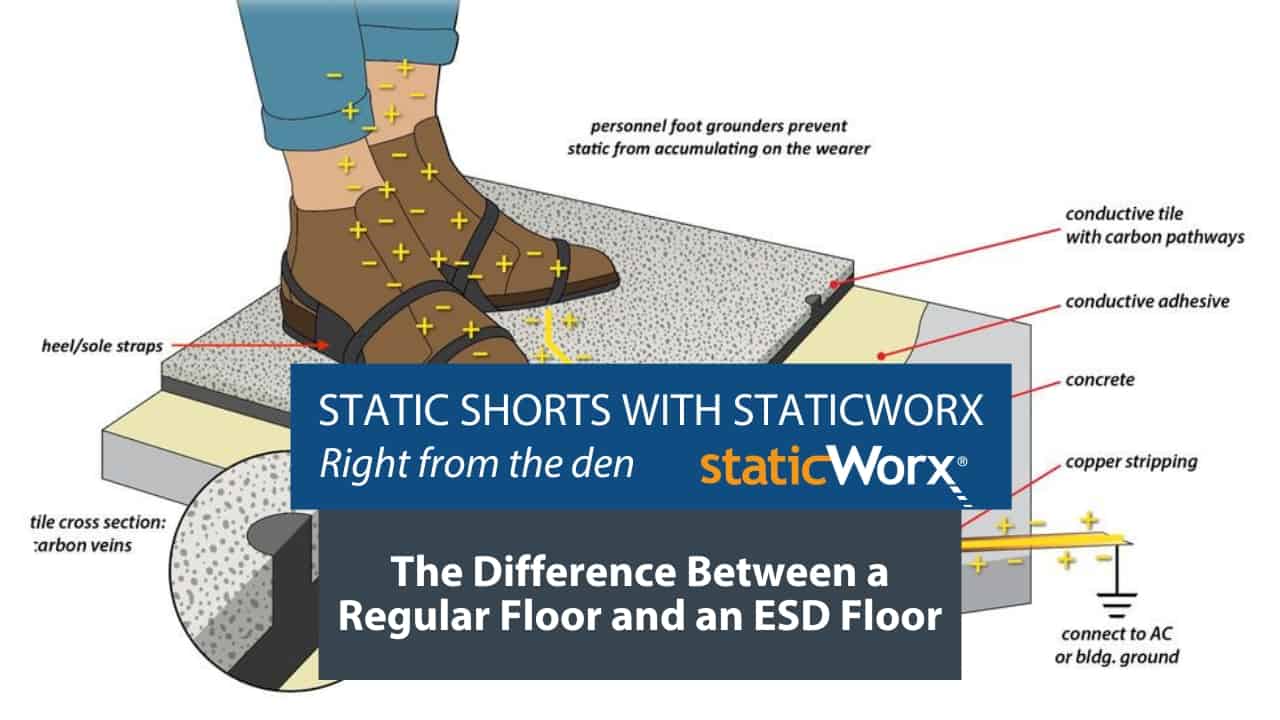
Video: Qualifying an ESD floor - Resistance and Charge Generation
October 9, 2019
ESD flooring materials should always be tested and qualified as an ESD flooring system – i.e. in combination with a person and whatever footwear is designated for the space. In this video, Dave Long, president and founder of StaticWorx, Inc., explains industry standards for static-control flooring – and details the tests necessary to properly qualify an ESD floor. You’ll learn why resistance testing alone is not enough to ensure an ESD-safe floor. And why it’s crucial to test both electrical resistance, measured in ohms, and charge generation, measured in volts.
Visit our Learning Center to read our article, 5 Reasons You Should Never Qualify a Floor Based on Conductive or Dissipative.
For help or advice about choosing an ESD floor, call us on 617-923-2000, email [email protected], or visit our Guide to ESD Flooring Selection.
Hi, I’m Dave Long from StaticWorx. Today we’re going to talk about qualifying ESD flooring.
This past September, In Compliance Magazine published our article on this topic and the reason we wrote the article is most people that we deal with – engineers, facility managers, architects – don’t realize that there’s actually a special process called qualifying an ESD floor. What I’m telling you is qualifying the floor is different than testing the floor. It’s different than verifying the floor.
In our industry we all try to meet a standard called ANSI 20.20 and ANSI 20.20 is a document that clearly states that before you install a static-control floor under laboratory conditions you need to perform certain tests and those tests should be done with environmental controls in place.
So there’s two tests. The first one is what we call the ohm meter test. Everyone’s familiar with this and in fact 10 years ago if you were doing qualification you would very likely get away possibly with only doing this test.
So all I’m gonna do is hit a button and that tells me what the electrical resistance of this conductive tile is. So typically when we go into a facility and we talk to people, they think that’s all they have to do. All that test does is tell you what the electrical resistive properties of the floor are and it doesn’t tell you anywhere near enough. So now with the 2014 version of ANSI 20.20 it’s a requirement in the lab to test the floor for walking body voltage using the specific type of footwear you plan to use in your facility.
So what are the footwear options? Here’s an ESD shoe. These black pads on here are conductive materials that are electrically connected to the inside of the shoe.
Here’s a heel strap. As you can see, the heel strap is on a regular ordinary sneaker and it’s only a small band of conductive material.
We’ve got cleanroom booties. This little tab goes inside your shoe. This allows the electricity – all of these actually do – on your body to be transferred from your skin to these conductive materials to the floor to ground.
The funny thing about it is you would assume that any of these ESD footwear options would work very well. They don’t. Certain floors do not perform very well for certain types of ESD footwear. In our article there’s a chart and one of the things we’ve done is we’ve actually taken third-party lab data, presented it, showing the reader what the charge generation is on the same floor using heel straps and ESD shoes.
Probably the most graphic example of why you need to understand this: one of the floors we tested was a conductive vinyl floor, so with the ohm meter it measured exactly where it was supposed to measure, in the conductive range in that particular case, but when we walked on it with an ESD heel strap, we measured 800 volts. The manufacturer claimed that this floor met ANSI 20.20. In fact, it’s in their warranty. What they left out is when they did the testing, they did it themselves, they did it at the wrong humidity, and they did it with ESD shoes. Well, if you’re going to use ESD shoes that might help a little bit but the problem we have is we want to know whether a floor will work under adverse circumstances. That means we want to know what’s going to happen when the humidity is low. We also want to know whether the floor is going to generate static electricity on the rest of the shoe.
So if I take this sneaker and I rub it on this carpet, I generate a static charge. What you’ll notice with the heel strap is there’s no static but for the rest of the shoe there is. One of the reasons heel straps are an important test, is we know that most of a standard shoe with a heel strap, most of that shoe is going to generate static electricity. The only part that’s going to prevent static electricity is this small band.
So if we can find a floor the works with heel straps and works with ESD shoes, we’ve got a floor that means we don’t have to worry about swapping what type of footwear we use in the future. If a visitor comes into our facility, we can hand them a set of heel straps and know that they can touch their product without damaging it. That’s a big deal.
So now you don’t have to put the floor in, only to find out that you have to spend $100 or more per employee in order to find a footwear option that will work for that floor.
Have you seen...


Learning Center Articles
- ESD Basics
- Installation & Maintenance
- Selecting & Specifying an ESD Floor
- Technical Information
- 7 Common Mistakes Selecting an ESD floor
- A Guide to ESD Flooring Selection
- Avoid Costly Failures: What You Need to Know When Specifying ESD Flooring
- Choosing ESD Flooring for:
- ESD Footwear: What Is It and When Is It Necessary?
- ESD Footwear for Electronics Manufacturing and Handling Applications
- Facility Managers’ Guide to Selecting ESD Flooring
- The Need for Due Diligence in Specifying Static-Free Flooring
- Standard of Care for Specifying Floors in Mission-Critical Spaces
- Understanding the Hidden Costs of ESD Flooring

StaticWorx high-performance static-control floors protect electronic components, explosives, and high-speed computers from damage caused by static electricity. ESD flooring is part of a system. Choices should always be based on objective, researched evidence. When you partner with us, we look at all possible items that may need to integrate with the floor, and, focusing on your goals and objectives, help you find the right floor for your application.








